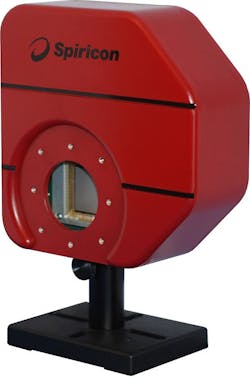Pyrocam IV images laser beams to terahertz range

Ophir-Spiricon's pyroelectric or thermal-electric Pyrocam cameras have allowed laser users working with ultraviolet (UV), infrared (IR), and terahertz (THz) wavelengths to image and characterize laser sources for more than 30 years. But the new, fourth-generation Pyrocam IV (see video at http://bcove.me/iq5gsjqt) adds greater sensitivity, better resolution, a larger active area, and more compact packaging to address next-generation laser source requirements.
RELATED ARTICLE: How to select a beam-profile measurement system
Better sensitivity of the Pyrocam IV's imager allows profiling of lasers with lower power density levels than the Pyrocam III. While the Pyrocam III specified a sensitivity level of 2.2 mW/cm2 at a 24 Hz chop rate, the Pyrocam IV specifies 1.0 mW/cm2 at its equivalent chop rate. Pyrocam IV also has a 36% higher saturation level of 3.0 W/cm2 compared to the Pyrocam III's 2.2 W/cm2 (at equivalent chop rates), giving the Pyrocam IV the greatest range of usable power densities to date. Military labs and those working with low-level THz sources (usually working in tens of microwatts to single-digit milliwatt ranges) benefit from this increased sensitivity. Recently, one of the Naval Research Lab’s laser scientists was thrilled to be able to see his terahertz beam for the very first time.
The 20% smaller pixel pitch from the Pyrocam III's 100 µm to the Pyrocam IV's 80 µm pitch enables more flexibility, both in beam sizes being profiled and the amount of data being collected. DoE and DoD research facilities and others working with relatively small beams have commented that they are now able to collect more reliable data with more pixels illuminated. Used in conjunction with Spiricon's newly-released LBS-400 beam attenuation system, laser users can accurately image focused spots up to 500 W of average power and down to about 1.5 mm in diameter. This allows for the characterization of high-powered industrial lasers being used in manufacturing environments.
The Pyrocam IV uses an active area of 25.6 mm square that is more than twice that of the Pyrocam III’s 12.4 mm square active area. Couple this with the smaller pixels and the result is Pyrocam IV's 320 x 320 resolution compared to Pyrocam III's 124 x 124 resolution. Recently, a fiber manufacturer purchased a Pyrocam IV on the spot after experiencing the beam divergence measurements from his highly-divergent light. The large active area allowed them to take measurements that ultimately led to qualification of their products that they had not previously been able to accomplish.
Technological advancements have allowed for more compact packaging in the Pyrocam IV. While the predecessor Pyrocam III has a thickness of just over 3 inches, the Pyrocam IV is 2.18 inches thick. And while the overall width and height dimensions are similar between the two cameras, the Pyrocam IV has progressed past a rectangular shape to allow the laser user more flexibility in its placement. The Pyrocam IV case also has different interfaces, such as an SMA connection instead of a BNC connection for triggering the camera to allow for more efficient cable management.
Because Ophir-Spiricon realizes that the new case design could cause problems for customers who would like to use the new Pyrocam IV but have system designs around the Pyrocam III form factor, the company is introducing the Pyrocam III-HR which has the new Pyrocam features packaged in the Pyrocam III case.
Some additional Pyrocam IV upgrades are that Ophir-Spiricon has moved away from the legacy FireWire interface to a Gigabit Ethernet interface. Also, in conjunction with the introduction of the Pyrocam IV, the company's BeamGage beam analysis software has also gone through some updates. The most recent release of v6.3 (a free upgrade to those using BeamGage v5.0 or later), allows for a more user-friendly interface to the Pyrocam camera, as well as several front-end and back-end software enhancements.
For more detailed information on Pyrocam IV, please contact Ophir-Spiricon product specialist John McCauley at [email protected].
SOURCE: Ophir-Spiricon; http://www.laserfocusworld.com/articles/2014/04/ophir-photonics-to-showcase-pyroelectric-camera-for-2d-3d-laser-diagnostics-at-spie-dss-2014.html
About the Author

Gail Overton
Senior Editor (2004-2020)
Gail has more than 30 years of engineering, marketing, product management, and editorial experience in the photonics and optical communications industry. Before joining the staff at Laser Focus World in 2004, she held many product management and product marketing roles in the fiber-optics industry, most notably at Hughes (El Segundo, CA), GTE Labs (Waltham, MA), Corning (Corning, NY), Photon Kinetics (Beaverton, OR), and Newport Corporation (Irvine, CA). During her marketing career, Gail published articles in WDM Solutions and Sensors magazine and traveled internationally to conduct product and sales training. Gail received her BS degree in physics, with an emphasis in optics, from San Diego State University in San Diego, CA in May 1986.